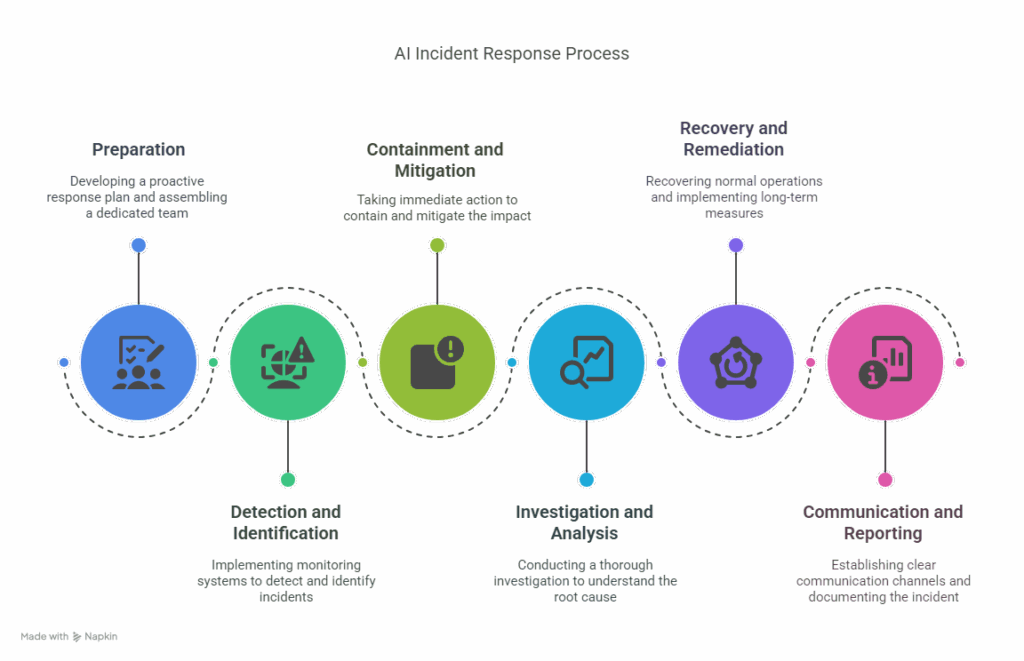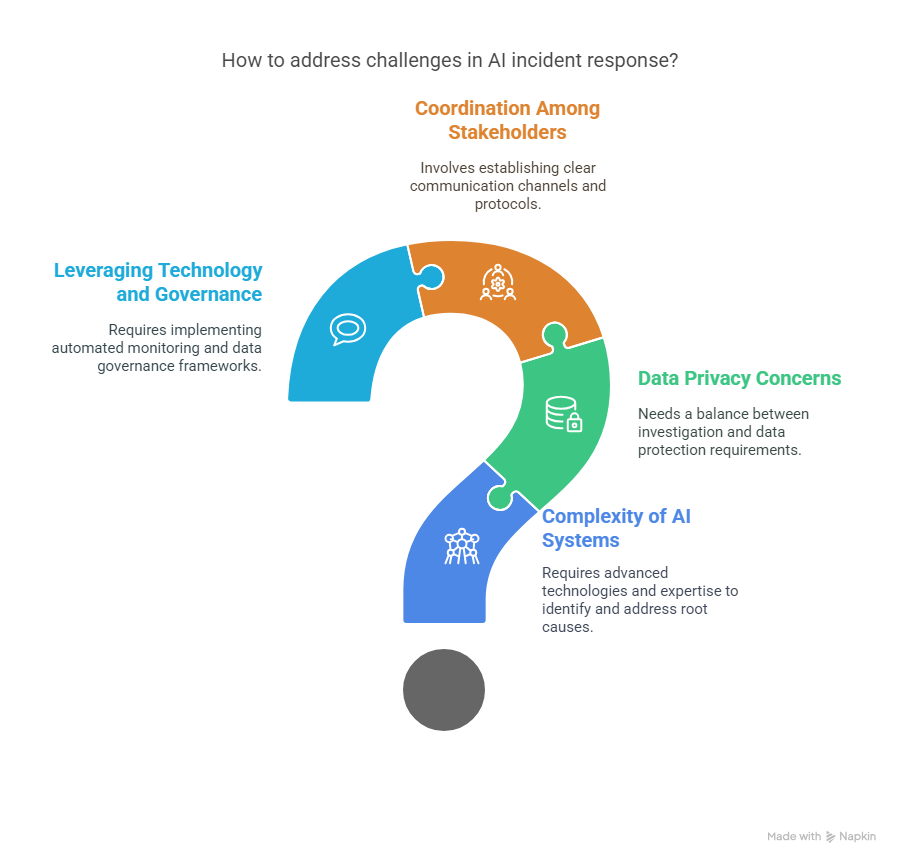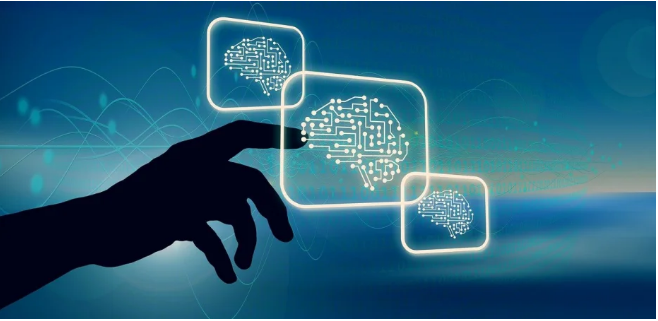MAY NOT BE REPRODUCED WITHOUT PERMISSION
We are just beginning to see the power of artificial intelligence and the ways it is changing how people work and interact with machines. It seems like we are seeing amazing breakthroughs and new innovations almost daily. However, eliminating unintended consequences like bias remains a challenge.
AI systems are becoming increasingly complex and integrated into critical domains. With the AI market forecast to grow to $190 billion by 2025, the impact on individuals, organizations, and society at large becomes magnified.
The stakes are high. PwC estimates that AI can contribute $15.7 trillion to the global economy by 2030. As companies accelerate AI development to get their share of the market, the need for robust AI incident response strategies has become a crucial component of responsible AI governance. When incidents occur, it is crucial that developers act swiftly to avoid causing harm.
Understanding AI Incident Response
AI incident response is the process of detecting, analyzing, and responding to events or situations that have the potential to cause harm or disruption due to the use of AI systems. It involves the coordination of people, processes, and technologies to effectively manage and mitigate the impact of AI incidents.
Types of AI Incidents
AI incidents can take several forms, which may pose unique challenges and require a customized response strategy. For example:
- Algorithmic errors: Flaws or bugs in the underlying algorithms, leading to incorrect or unexpected outputs.
- Data breaches: Unauthorized access, theft, or misuse of the data used to train or operate AI systems.
- Unintended Bias: When AI systems exhibit discriminatory or biased behavior due to biases present in the training data or algorithms.
- Ethical concerns: Use of AI systems violates ethical principles, such as privacy, transparency, or accountability.
- System failures: Hardware or software malfunctions, leading to system crashes or service disruptions.
Importance of AI Incident Response
Deployment and adoption of AI require trust. Users must trust the underlying algorithms to accept the outputs. AI incident response helps foster this trust while mitigating harm and ensuring regulatory compliance.
Minimizing Harm
Prompt and effective incident response can minimize the harm caused by AI failures and unintended consequences. By rapidly identifying and addressing issues, organizations can prevent incidents from escalating and reduce any negative impact.
Maintaining Trust
AI incidents, if not properly managed, can erode public trust and undermine confidence in the technology itself. Strategic AI incident management strategies demonstrate an organization’s commitment to ethical AI governance, helping to maintain trust among users and stakeholders.
Regulatory Compliance
As AI systems become integrated into apps and industries regulatory bodies are increasingly introducing guidelines and laws to govern their development and use. For example, the European Union (EU) has new legislation taking effect in 2026 that bans the use of AI in social scoring, predictive policing, and facial imaging in many cases.
In the U.S., 18 states and Puerto Rico adopted legislation or resolutions regarding AI in 2023.
AI incident response plays a vital role in supporting compliance with legal and regulatory requirements, ensuring organizations meet their obligations for the ethical use of AI.
Steps in the AI Incident Response Process
Effective AI incident response requires a structure to enable a coordinated and prompt response. While your incident response plan may vary, here is a common response framework that many companies use.

Preparation
A proactive response plan is crucial for effective incident management. This phase involves several key activities:
- Developing a comprehensive AI incident response plan that outlines roles, responsibilities, and procedures. The plan should be tailored to the specific AI systems and potential incident scenarios faced by the organization.
- Assembling a dedicated incident response team with cross-functional expertise, including technical professionals, legal advisors, communication specialists, and representatives from relevant business units
- Conducting regular training and simulations to ensure the team is prepared to respond effectively to various AI incident scenarios. Simulations help identify gaps in the plan, improve coordination, and build the team’s confidence in handling real-life incidents.
Detection and Identification
Early detection and accurate identification of an AI incident are critical for initiating an effective response. Strategies include:
- Implementing monitoring systems and processes to detect AI incidents promptly. This may include automated monitoring tools, anomaly detection algorithms, or user-reported incident reporting mechanisms.
- Accurately identifying the nature and scope of the incident, including its potential impact and affected systems or stakeholders. For example, if an AI system exhibits unintended bias, it’s essential to understand the extent of the bias and who may be affected.
Containment and Mitigation
Once an incident is detected and identified, immediate action must be taken to contain its impact and mitigate further harm. Best practices include:
- Implementing temporary measures to contain the incident and prevent further damage or harm. For instance, if an AI system experiences a data breach, immediate steps may include disconnecting the system from external networks and limiting access to sensitive data.
- Mitigating the immediate impact by addressing the root cause or implementing workarounds. This could involve applying software patches, updating algorithms, or temporarily suspending the use of the affected AI system.
Investigation and Analysis
A thorough investigation and analysis are necessary to understand the root cause of the incident and identify areas for improvement, such as:
- Conducting a comprehensive investigation to understand the root cause of the incident, including any underlying vulnerabilities or contributing factors. This typically starts by analyzing system logs, reviewing code, and examining training data.
- Analyzing the impact of the incident on affected individuals, systems, and processes. This analysis helps quantify the extent of the damage and focus recovery and remediation efforts.
- Identifying lessons learned and areas for improvement in the incident response process. These insights can be used to enhance the organization’s preparedness and response capabilities for future incidents.
Recovery and Remediation
After containing and investigating the incident, the focus shifts to recovering normal operations and implementing long-term remediation measures. This phase involves:
- Developing and implementing a plan to recover from the incident and restore normal operations. This may include restoring data from backups, deploying updated AI models, or gradually reintroducing systems into production environments.
- Implementing long-term remediation measures to address the identified vulnerabilities and prevent similar incidents from occurring in the future. These measures may include enhancing data quality controls, improving algorithm transparency, or implementing additional safeguards and monitoring mechanisms.
Communication and Reporting
Effective communication and reporting are also crucial throughout the incident response process.
Establishing clear communication channels to inform relevant stakeholders, including affected individuals, regulatory bodies, and the public (if necessary). Transparent and timely communication is key to maintaining trust and credibility.
It will also be important to document the incident and the response for future reference and analysis. Detailed documentation helps you capture the lessons learned to help guide future AI incident response.
Best Practices for AI Incident Response
Gartner’s 2024 CEO Survey reports that 87% of CEOs believe the benefit outweighs the risk with AI, With a topline focus on growth in the years ahead, a third of CEOs say AI is key to digital transformation.
Following a few best practices can help you develop appropriate AI incident response strategies to mitigate potential AI harm.
Clear Roles and Responsibilities
Define clear roles and responsibilities within the incident response team, ensuring that each member understands their tasks and decision-making authority. This clarity facilitates efficient coordination and timely response.
Regular Audits and Reviews
Conduct regular audits and reviews of AI systems to identify potential vulnerabilities or areas of improvement. This proactive approach can help prevent incidents or minimize their impact when they do occur.
Continuous Improvement
Treat each AI incident as a learning opportunity. Use the insights gained from past incidents to continuously improve the incident response plan, processes, and procedures. Regularly review and update the plan to reflect changes in AI systems, regulations, or best practices.
Challenges in AI Incident Response
While AI incident response is crucial for responsible AI governance, organizations face several challenges in implementing effective strategies:

Complexity of AI Systems
AI systems can be highly complex, with intricate interactions between data, algorithms, and underlying infrastructure. This complexity can make identifying and addressing the root cause of incidents challenging.
Data Privacy Concerns
AI systems often rely on large datasets, which may contain sensitive or personal information. Incident response efforts must balance the need for investigation and remediation with data privacy and protection requirements.
Coordination Among Stakeholders
AI incidents may involve multiple stakeholders, including developers, vendors, regulators, and end-users. Coordinating an effective response across these diverse groups can be complex and time-consuming.
Leveraging Technology and Governance
To address these challenges, organizations should leverage advanced technologies, such as automated monitoring and incident detection along with automated incident response solutions. However, it starts with a data governance framework, establishing clear guidelines and protocols for data privacy and incident reporting to streamline the response process. The right AI tools will help keep your data secure and private, and aid in incident response.
Final Thoughts
Organizations must prioritize the development and implementation of robust AI incident response plans as part of their overall AI governance framework.
By adopting a proactive and comprehensive approach to incident response, organizations can not only minimize harm but also foster trust and confidence in the responsible development and deployment of AI technologies.

